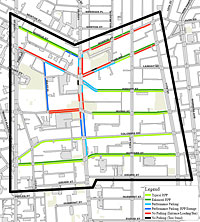Columbia Heights parking report needs more detail
In this morning’s post, I wrote about DDOT’s recommendation to raise meter rates on three blocks in Columbia Heights because average occupancy exceeds the 85% target.
However, reporting average occupancy is a little misleading. These numbers reflect the average over the entire day, not the busiest times.
If the goal of performance parking is to ensure that a space on every block is always available to people that are arriving to the area, then reporting average occupancy rates doesn’t do much good, because overcrowded parking at one time could be balanced by empty parking at another time. And empty spaces at 10 am don’t help people who are looking for spaces at 6 pm.
All six blocks had some time periods over 85%; according to the report, the maximum utilization on all six blocks ranged from 110% to 190%. (Maximum utilization can exceed 100% when people park extra-tightly, use very small cars, and/or park illegally.) But we also don’t know if those high utilizations were only one hour of one day, or common every day at a certain busy hour.
It would be better if DDOT reported the occupancy rates for each block at different times of day, so decisionmakers can see whether the meters are full nearly all the time, or only for a couple hours in the evening. With only an average and maximum value reported, it’s hard to tell. DDOT could copy the format of this report for the Port of San Francisco, where each block gets its own page, showing the occupancy at all hours of the day, every day of the week.
If a block is always crowded at 6 pm but empty at 11 am, rather than raising rates across the board, DDOT should raise rates more at 6 pm and even lower them at 11 am. There is of course a balance between making the pricing scheme fit the occupancy very closely but with a lot of complexity, and having it be simple but overcharge during off-peak hours. If it’s too complex for meters to vary by hours of the day, they could set prices so that the occupancy exceeds the 85% target about 15% of the time at most. In other words, take all the hours for a block and throw out those with the 15% highest occupancy rates. Then pick the highest remaining hour and target that. If occupancy is not between 80 and 90%, raise or lower the price a bit, then measure again.
These measurements that can exceed 100% are also tough to use for policy. Unlike many on-street parking environments such as Arlington’s, where the spaces are clearly marked with painted lines, the study blocks don’t have a fixed number of parking spaces. This limits the value of the data collected. It’s hard to tell whether a block reporting 100% occupancy is really full, or just partially full of smaller, tightly packed cars. An improvement would be to report whether there is an empty space longer than 18-20 feet, which would be an indicator that enough available parking exists. I don’t know how you would collect this data automatically, unfortunately.
It’s great that DDOT collected the data and put out this report, which helps people understand the parking situation in Columbia Heights. It’s also great that the report describes what performance parking is all about, and that DDOT appears to be drawing some of the right conclusions from the data.
However, setting meter rates simply based on the average utilization misses a lot of information. Raising the rates on three of the six blocks might be the right policy, or it might still leave most people unable to park at most of the busier times. More and better data would help

